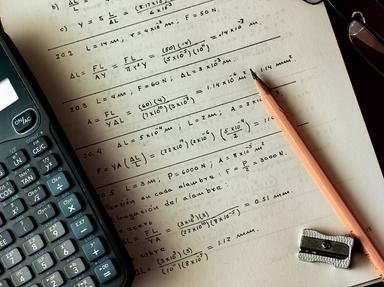Quiz Answer Key and Fun Facts
1. As a follow-up of the instructions, no Fill-In-The-Blank question will have any special characters in the answer. Let's begin!
There is a new population of deer in a field in a National Park. Their growth can be modeled logistically (not exponentially - after all, there is only so much food and living space) based on the formula (deer vs. time): d(t)=(1500e^t-20)/(1000+20e^t-20). What is that field's carrying capacity? (The maximum number of deer it can sustain?)
2. A car travels along the path such that the displacement vs. time (meters vs. seconds) graph is given by the equation: x(t)=(6/π)sin^-1(t)*cos^-1(t). What is the instantaneous velocity of the car at the point (1/2, π/3)?
3. Annie has a 2-inch piece of chalk. Each inch of chalk can draw 1000 feet of lines. She wants to draw a curve modeled by the equation x^(3/2). She envisions the curve drawn on a plot where each unit on the x-axis and y-axis is equal to 1 yard (1 yard=3 feet). She draws the curve starting at the origin and ending at the point (44, 44^(3/2)). How many inches of chalk does Annie have remaining after she draws this curve?
4. Sylvia the potter has just completed a large order of ornate clay bowls but has just realized that she is one short. She only has 1 cubic foot of clay left. Does she have enough to make the last bowl? (The bowl can be modeled by region bounded by y=x^2 and y=√x when rotated around the x-axis.)
5. A strange and unusual particle moves with velocity equal to v(t)=t^10*ln(t) m/s. You observe this particle carefully in a lab and find that over the time interval [1, e^(1/11)] the particle moves _______ meters.
Hint: Integration by parts is used to find the antiderivative of a product. Its formula is ∫udv = uv-∫vdu.
6. An old man with a bad back wants to hang a plane mirror on his wall and wants to know what angle it will make with the floor so that he can lie down on his back under it and watch TV from across the room. The problem is, his house was designed by Frank Gehry and the wall is modeled by the equation z=½x^2+¼y^2. He wants to attach the mirror to the wall tangent to the point (2,4,6). What angle will this tangent mirror (plane) make with the floor? (You can assume that the floor is represented by the equation z=0.)
7. A factory producing computers has two factors that contribute to production: labor (L) and capital (K). The number of computers they can produce in an hour is given by the function P=100L^0.4K^0.6. Unfortunately, the factory's budget is $3000 per hour and one unit of labor costs $75 per hour and one unit of capital costs $100 per hour. To produce the most computers in one hour, how many units of labor should the factory employ and how many units of capital should they use? Write your answer as the ordered pair L,K where L is the number of units of labor and K is the number of units of capital.
8. Everyone (OK, some) people know that e^(x^2) is not integrable by normal means of antidifferentiation. However, in double integrals it is possible sometimes to reverse the order of integration (do dy dx instead of dx dy) in order to solve an otherwise impossible integral. Try solving this:
∫[0;1] ∫[3y;3] e^(x^2)dxdy (The bounds are [0,1] and [3y,3] in case they're hard to read there.)
9. You go out for dinner at Papa Raboloid's Italian Bistro and order his signature 16π drink. He pours 16π cubic centimeters of reddish liquid into your paraboloidic cup. (Your cup can be modeled by the equation z=2x^2+2y^2.) Your cup is 10 cm tall. How many centimeters will be left unfilled at the top of the cup?
Hint 1: A paraboloid is a 3D parabola with a circular top, and the most basic form is given by z=x^2+y^2.
Hint 2: It may be helpful to use polar coordinates.
10. Luke Skywalker travels in his X-Wing along a path C given by the boundary of the area enclosed by a semicircle of radius 3 units, semicircle of radius 1 unit, and the x-axis. (This path is entirely in Quadrants I & II.) A variable force field, created by Darth Vader and given by (2y^2)i+(8xy)j --- (i and j are the unit vectors [[1,0]] and [[0,1]]) --- is present. How much work is done on Luke by Vader's force field as he travels completely around the closed loop once? Write your answer as an improper fraction a/b without any units.
Source: Author
redsoxfan325
This quiz was reviewed by FunTrivia editor
crisw before going online.
Any errors found in FunTrivia content are routinely corrected through our feedback system.
